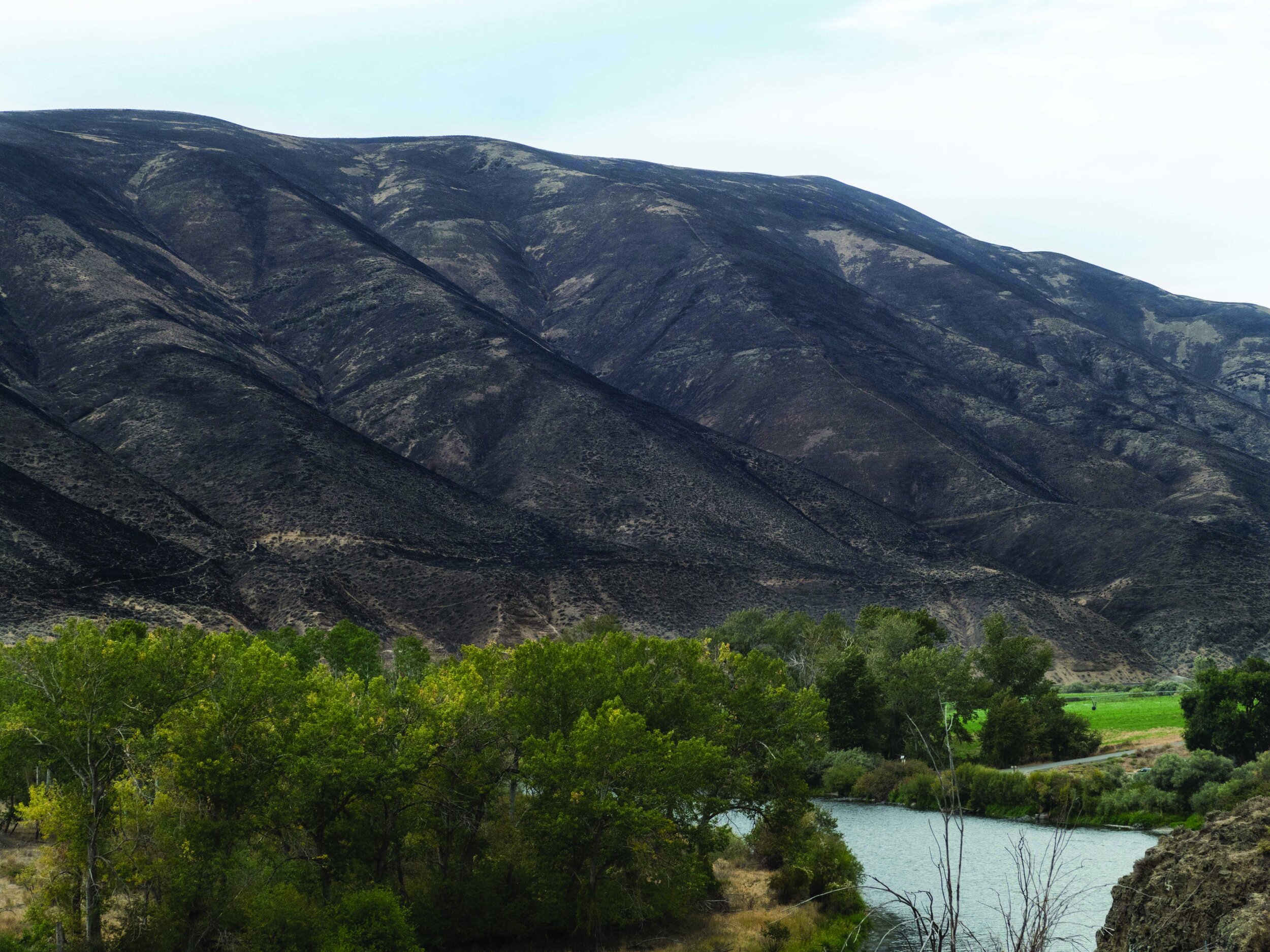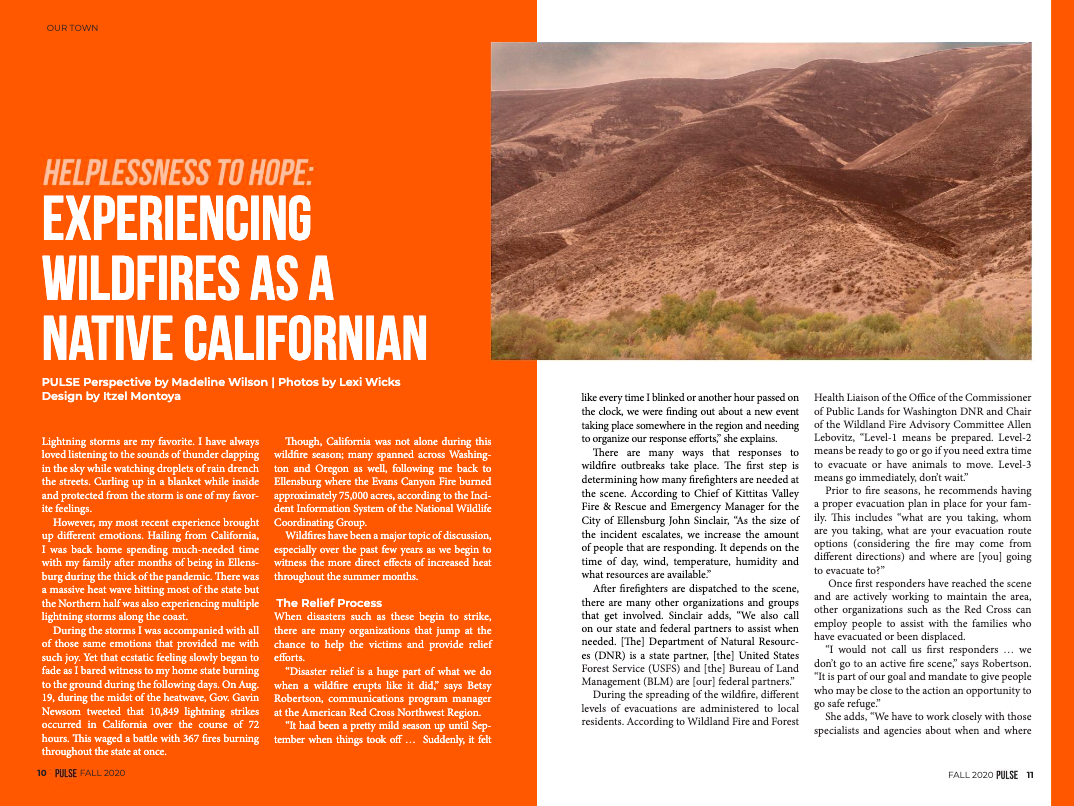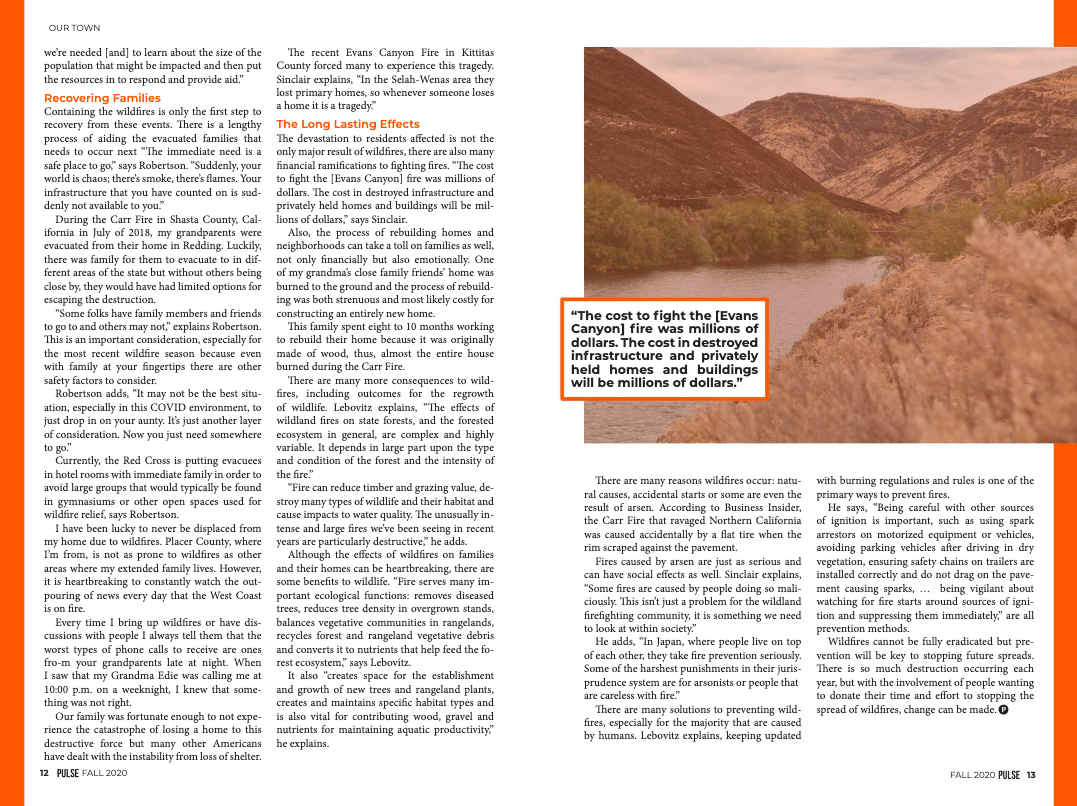Helplessness to Hope: Experiencing Wildfires as a Native Californian
PULSE Perspective by Madeline Wilson | Photos by Lexi Wicks | Design by Itzel Montoya
Lightning storms are my favorite. I have always loved listening to the sounds of thunder clapping in the sky while watching droplets of rain drench the streets. Curling up in a blanket while inside and protected from the storm is one of my favorite feelings.
However, my most recent experience brought up different emotions. Hailing from California, I was back home spending much-needed time with my family after months of being in Ellensburg during the thick of the pandemic. There was a massive heat wave hitting most of the state but the Northern half was also experiencing multiple lightning storms along the coast.
During the storms I was accompanied with all of those same emotions that provided me with such joy. Yet that ecstatic feeling slowly began to fade as I bared witness to my home state burning to the ground during the following days. On Aug. 19, during the midst of the heatwave, Gov. Gavin Newsom tweeted that 10,849 lightning strikes occurred in California over the course of 72 hours. This waged a battle with 367 fires burning throughout the state at once.
Though, California was not alone during this wildfire season; many spanned across Washington and Oregon as well, following me back to Ellensburg where the Evans Canyon Fire burned approximately 75,000 acres, according to the Incident Information System of the National Wildlife Coordinating Group.
Wildfires have been a major topic of discussion, especially over the past few years as we begin to witness the more direct effects of increased heat throughout the summer months.
The Relief Process
When disasters such as these begin to strike, there are many organizations that jump at the chance to help the victims and provide relief efforts.
“Disaster relief is a huge part of what we do when a wildfire erupts like it did,” says Betsy Robertson, communications program manager at the American Red Cross Northwest Region.
“It had been a pretty mild season up until September when things took off … Suddenly, it felt like every time I blinked or another hour passed on the clock, we were finding out about a new event taking place somewhere in the region and needing to organize our response efforts,” she explains.
There are many ways that responses to wildfire outbreaks take place. The first step is determining how many firefighters are needed at the scene. According to Chief of Kittitas Valley Fire & Rescue and Emergency Manager for the City of Ellensburg John Sinclair, “As the size of the incident escalates, we increase the amount of people that are responding. It depends on the time of day, wind, temperature, humidity and what resources are available.”
After firefighters are dispatched to the scene, there are many other organizations and groups that get involved. Sinclair adds, “We also call on our state and federal partners to assist when needed. [The] Department of Natural Resources (DNR) is a state partner, [the] United States Forest Service (USFS) and [the] Bureau of Land Management (BLM) are [our] federal partners.”
During the spreading of the wildfire, different levels of evacuations are administered to local residents. According to Wildland Fire and Forest Health Liaison of the Office of the Commissioner of Public Lands for Washington DNR and Chair of the Wildland Fire Advisory Committee Allen Lebovitz, “Level-1 means be prepared. Level-2 means be ready to go or go if you need extra time to evacuate or have animals to move. Level-3 means go immediately, don’t wait.”
Prior to fire seasons, he recommends having a proper evacuation plan in place for your family. This includes “what are you taking, whom are you taking, what are your evacuation route options (considering the fire may come from different directions) and where are [you] going to evacuate to?”
Once first responders have reached the scene and are actively working to maintain the area, other organizations such as the Red Cross can employ people to assist with the families who have evacuated or been displaced.
“I would not call us first responders … we don’t go to an active fire scene,” says Robertson. “It is part of our goal and mandate to give people who may be close to the action an opportunity to go safe refuge.”
She adds, “We have to work closely with those specialists and agencies about when and where we’re needed [and] to learn about the size of the population that might be impacted and then put the resources in to respond and provide aid.”
Recovering Families
Containing the wildfires is only the first step to recovery from these events. There is a lengthy process of aiding the evacuated families that needs to occur next “The immediate need is a safe place to go,” says Robertson. “Suddenly, your world is chaos; there’s smoke, there’s flames. Your infrastructure that you have counted on is suddenly not available to you.”
During the Carr Fire in Shasta County, California in July of 2018, my grandparents were evacuated from their home in Redding. Luckily, there was family for them to evacuate to in different areas of the state but without others being close by, they would have had limited options for escaping the destruction.
“Some folks have family members and friends to go to and others may not,” explains Robertson. This is an important consideration, especially for the most recent wildfire season because even with family at your fingertips there are other safety factors to consider.
Robertson adds, “It may not be the best situation, especially in this COVID environment, to just drop in on your aunty. It’s just another layer of consideration. Now you just need somewhere to go.”
Currently, the Red Cross is putting evacuees in hotel rooms with immediate family in order to avoid large groups that would typically be found in gymnasiums or other open spaces used for wildfire relief, says Robertson.
I have been lucky to never be displaced from my home due to wildfires. Placer County, where I’m from, is not as prone to wildfires as other areas where my extended family lives. However, it is heartbreaking to constantly watch the outpouring of news every day that the West Coast is on fire.
Every time I bring up wildfires or have discussions with people I always tell them that the worst types of phone calls to receive are ones fro-m your grandparents late at night. When I saw that my Grandma Edie was calling me at 10:00 p.m. on a weeknight, I knew that something was not right.
Our family was fortunate enough to not experience the catastrophe of losing a home to this destructive force but many other Americans have dealt with the instability from loss of shelter.
The recent Evans Canyon Fire in Kittitas County forced many to experience this tragedy. Sinclair explains, “In the Selah-Wenas area they lost primary homes, so whenever someone loses a home it is a tragedy.”
The Long Lasting Effects
The devastation to residents affected is not the only major result of wildfires, there are also many financial ramifications to fighting fires. “The cost to fight the [Evans Canyon] fire was millions of dollars. The cost in destroyed infrastructure and privately held homes and buildings will be millions of dollars,” says Sinclair.
Also, the process of rebuilding homes and neighborhoods can take a toll on families as well, not only financially but also emotionally. One of my grandma’s close family friends’ home was burned to the ground and the process of rebuilding was both strenuous and most likely costly for constructing an entirely new home.
This family spent eight to 10 months working to rebuild their home because it was originally made of wood, thus, almost the entire house burned during the Carr Fire.
There are many more consequences to wildfires, including outcomes for the regrowth of wildlife. Lebovitz explains, “The effects of wildland fires on state forests, and the forested ecosystem in general, are complex and highly variable. It depends in large part upon the type and condition of the forest and the intensity of the fire.”
“Fire can reduce timber and grazing value, destroy many types of wildlife and their habitat and cause impacts to water quality. The unusually intense and large fires we’ve been seeing in recent years are particularly destructive,” he adds.
Although the effects of wildfires on families and their homes can be heartbreaking, there are some benefits to wildlife. “Fire serves many important ecological functions: removes diseased trees, reduces tree density in overgrown stands, balances vegetative communities in rangelands, recycles forest and rangeland vegetative debris and converts it to nutrients that help feed the fo-rest ecosystem,” says Lebovitz.
It also “creates space for the establishment and growth of new trees and rangeland plants, creates and maintains specific habitat types and is also vital for contributing wood, gravel and nutrients for maintaining aquatic productivity,” he explains.
There are many reasons wildfires occur: natural causes, accidental starts or some are even the result of arsen. According to Business Insider, the Carr Fire that ravaged Northern California was caused accidentally by a flat tire when the rim scraped against the pavement.
Fires caused by arsen are just as serious and can have social effects as well. Sinclair explains, “Some fires are caused by people doing so maliciously. This isn’t just a problem for the wildland firefighting community, it is something we need to look at within society.”
He adds, “In Japan, where people live on top of each other, they take fire prevention seriously. Some of the harshest punishments in their jurisprudence system are for arsonists or people that are careless with fire.”
There are many solutions to preventing wildfires, especially for the majority that are caused by humans. Lebovitz explains, keeping updated with burning regulations and rules is one of the primary ways to prevent fires.
He says, “Being careful with other sources of ignition is important, such as using spark arrestors on motorized equipment or vehicles, avoiding parking vehicles after driving in dry vegetation, ensuring safety chains on trailers are installed correctly and do not drag on the pavement causing sparks, … being vigilant about watching for fire starts around sources of ignition and suppressing them immediately,” are all prevention methods.
Wildfires cannot be fully eradicated but prevention will be key to stopping future spreads. There is so much destruction occurring each year, but with the involvement of people wanting to donate their time and effort to stopping the spread of wildfires, change can be made.









